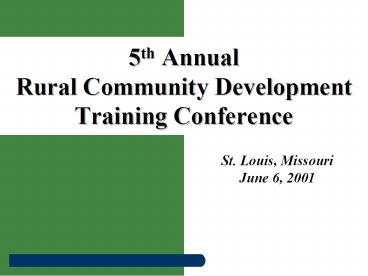5th Annual Rural Community Development Training Conference - PowerPoint PPT Presentation
1 / 51
Title:
5th Annual Rural Community Development Training Conference
Description:
Comparable assessment in 21 countries (compared to 10 in 1999) ... Mature Old Economy Industries. Women and Minorities. ROLE OF MICROENTERPRISE DEVELOPMENT ... – PowerPoint PPT presentation
Number of Views:50
Avg rating:3.0/5.0
Title: 5th Annual Rural Community Development Training Conference
1
5th AnnualRural Community DevelopmentTraining
Conference
St. Louis, Missouri June 6, 2001
2
Microenterprise Development Don Macke
3
-Todays Focus-
- Why Entrepreneurship?
- Role of Microenterprises
- Resources
- Questions Discussion
4
Rural Entrepreneurship InitiativeJune, 2001
Why Entrepreneurship?
WHY ENTREPRENEURSHIP?
5
INSIGHT 1
Entrepreneurship and Economic Performance
6
Global Entrepreneurship Monitor2000
7
What is GEM 2000?
- Collaborative effort of the worlds best scholars
in entrepreneurship to study the relationship
between entrepreneurship and economic growth. - Comparable assessment in 21 countries (compared
to 10 in 1999). - Based on a sample survey of the adult population,
in-depth interviews with national experts on
entrepreneurship in each country, and
standardized secondary data.
8
GEM 2000 Focuses on Three Questions
- Does the level of entrepreneurial activity vary
between countries, and if so, by how much? - Does the level of entrepreneurial activity affect
a countrys rate of economic growth? - What makes a country entrepreneurial?
9
Finding One The level of entrepreneurship
differs significantly between countries.
10
Finding Two Entrepreneurship is strongly
associated with economic growth?
- The level of entrepreneurial activity explains 70
percent of the difference in economic growth
among nations. - All nations with high levels of entrepreneurial
activity have above average rates of economic
growth. - Only a few nations that have above average rates
of economic growth have low levels of
entrepreneurship.
11
INSIGHT 2
- Weaker Rural Economic Performance is Due in Part
to Lower Levels of Entrepreneurial Activity?
12
Question?
- Do Rural Americans have a propensity to be
entrepreneurs?
13
Answer! Yes No
- Rural Americans have E-Traits.
- Major Challenges Exist.
- Fewer Entrepreneurial Growth Companies.
14
Question?
- Do Rural Americans Have the Knowledge and Skills
Associated with Entrepreneurship?
15
Answer! Yes No
- Strong Basic Skills.
- Weak Advanced Skills.
- Distance and Weak Support Infrastructure.
16
Question?
- Are Rural Americans Succeeding as Entrepreneurs?
17
Answer!
- Some.
- Fewer Than in Urban America.
- Barriers for Entrepreneurs.
- Entrepreneurs are Leaving.
18
INSIGHT 3
- Increasing Entrepreneurship in Rural America is a
Primary Strategy for Increasing Economic
Performance and Prosperity.
19
Increasing Rural Entrepreneurship
20
Challenge!
- How Do Rural Areas Increase Entrepreneurship?
21
Four Uniquely Rural E Challenges
- Market
- Isolation
- Culture
- Demographics
22
Market Challenges
- Accessing Urban Markets.
- Necessary Services.
- Clustering.
- Transition Local to National.
23
Isolation Challenges
- Less Isolation Today.
- Other Entrepreneurs.
- Perceiving Opportunities.
24
Cultural Challenges
- Anti-Change.
- Success/Failure.
- Recognition/Awareness.
- Social Entrepreneurs.
25
Demographic Challenges
- Education.
- Few 25-44 Males.
- Weaker Growth.
- Mature Old Economy Industries.
- Women and Minorities.
26
ROLE OF MICROENTERPRISE DEVELOPMENT
Role of Microenterprise Development
27
Rural America Working
Small Business Owners
Major Business Owner
Unemployed
Micro
Home Based
Salary Workers
Wage Workers
28
Rural Entrepreneurs
Active
Survival
Lifestyle
Aspiring
Growth
Potential
29
Support System
- Comprehensive
- Appropriate
- Effective
- Sustainable
30
Nebraskas Story
31
1980s -
- REAP
- Center for Rural Affairs
32
1997-
- Nebraska
- Microenterprise
- Partnership
- Fund
33
Intermediary
- Lending Capital
- Development Resources
- Training
- Performance
34
Resources
- 450,000
- 1.2 Million
- 2.7x
35
- NEON
- AEO
36
- State
- Recognition
- Legislation
37
Leveraged Stable State Resources
- 44 to 77
- Change
38
Performance
39
Lending
- 1998 - 743,000
- 2000 - 1,350,000
- 82
40
Training
- 1998 1,019
- 2001 2,863
- 181
41
Coverage
- Loans Training
- 1998 42 31
- 2000 49 79
- 17 155
42
Job Creation
- 1,700 Jobs per Year
43
Cost
- 1,573 per Loan
44
Default
- 2.2 Rate
45
Comparative Costs (Per Job)
- Micro 1,000
- CDBG 20,000
- Tax Abatement 50,000
46
National Fund for Enterprise Development
47
National
State
State
Local
Local
Local
48
Strategies for Creating a Systems Approach
Entrepreneur Profiling and Resource Matching
Local/Regional/State Integrated System
Service Provider Networking
Top Down
One Stop Referral Tracking Service
Paper and Electronic Directory Resources
Service Provider Cross-Training
Market Support Assistance
Meaningful Connection
Education of the Importance of Networks
Enterprise Clusters
Enterprise Associations
Bottom Up
Internal
External
Support in Creating Clusters and Associations
Entrepreneur Networking
49
Elements of a Rural Capital System
Capital Attraction
Rural Capital System
Venture Fund Connections
Rooted Venture Funds
Effective Use of Govt. Programs
NICs
Deal Development
Angel Networks
Micro Lending
Capital Literacy Education
50
Rural Entrepreneurship Initiative
51
For More Information. . . .
- Rural Entrepreneurship Initiative
http//www.nebcommfound.org - Rural Entrepreneurship Initiative
- Kauffman Foundation http//www.entreworld.org































